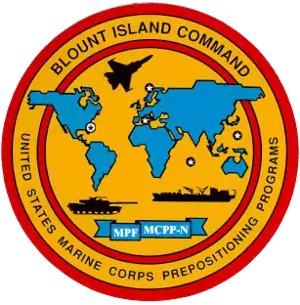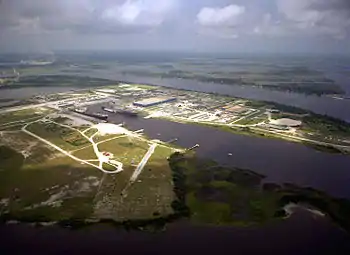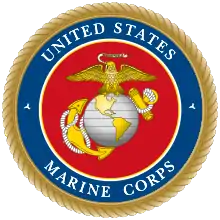Blount Island Command
Blount Island Command (BICmd) is responsible for the United States Marine Corps' Maritime Prepositioning Ships (MPS) Maintenance Cycle operations and oversight of the Marine Corps Prepositioning Program-Norway (MCPP-N). It is located on the east side of Blount Island.
| Blount Island Command | |
|---|---|
| Jacksonville, Florida | |
 BICmd logo | |
| Type | Logistics base |
| Site information | |
| Controlled by | United States Marine Corps |
| Site history | |
| Built | March 1942 |
| In use | 1986— present |
| Garrison information | |
| Garrison | Marine Corps Logistics Command |
History
The concept of a Maritime Prepositioning Force (MPF) was first envisioned during the late 1970s. The initial program, established in 1979, was called the Near Term Prepositioning Force (NTPF). NTPF used existing operational force equipment and supplies to load on available ships belonging to the Military Sealift Command (MSC). These ships were based in Diego Garcia and initial equipment and ship maintenance was done in Naha, Okinawa and Subic Bay Naval Base. The Marine Corps immediately recognized the advantages of prepositioning equipment and seized the opportunity to improve combat readiness.
In March 1983, the Commandant of the Marine Corps directed Marine Corps Logistics Base Albany to acquire the assets for the MPF program. MSC leased thirteen ships for the MPF program. The ships were formed into three Maritime Prepositioning Squadrons (MPSRONs). MPSRON 1 and 2 were loaded in Wilmington, North Carolina and MPSRON 3 was loaded in Panama City, Florida. The ammunition for all three squadrons was loaded at Military Ocean Terminal, Sunny Point, North Carolina.
Property leased
In 1986, the Marine Corps established the Biennial Maintenance Command (BMC) at Blount Island, Jacksonville, Florida on 262 acres (1.06 km2) leased from Gate Maritime Properties (GMP) for $11M per year. In 1989, Blount Island Command was established as a subordinate command to Marine Corps Logistics Bases, Albany, Georgia.

Property purchased
The lease between GMP and the Marine Corps was due to end in 2004, and in 2000, the Corps stated their intentions to purchase the property when the lease expired. The Marine Corps budget included $115.7 million for the acquisition, but extended negotiations did not result in an agreement. GMP contended that the land was worth between $160 million and $200 million, so in August 2004, the Marine Corps seized 1,100 acres (4.5 km2) on Blount Island (GMP's entire Blount Island holdings) by eminent domain and initially paid $101 million. When land is seized by eminent domain for uses that benefit the public, the government is required to pay landowners "just compensation", so GMP asked for a jury to decide the land's value. On November 14, 2005, a jury determined that the government must pay $160 million for the parcel.[1]
Facility
The base falls under the command of the Marine Corps Logistics Command located at Marine Corps Logistics Base Albany, Georgia. The portion of the Blount Island currently occupied by Blount Island Command began transitioning to become a Marine Corps Logistics Base in 2005. As of 2010, $55 million had been spent on projects to expand capabilities and improve security, including better fencing and gate access.[2] Blount Island offered a variety of advantages not available at any other site, including:
- A private slipway with 5 large vessel berths located only 7 nautical miles (13 km) from the St. Johns River outlet
- Proximity to Marine Corps Logistics Base Albany, Georgia
- Access to a large industrial base and Navy support structure in Jacksonville, Florida.
- Over 33 acres (0.13 km2) of staging immediately adjacent to the 1,000-foot (300 m) pier and maintenance area.
- Overflow staging and maintenance capacity for MPS offload and throughput training.
Operation
Each Maritime Prepositioning Ship (MPS) can supply a Marine Expeditionary Unit (2,200 members) for 30 days. Ships are loaded with thousands of different items required for logistical support. The vessel then departs Blount Island and journeys to an assigned ocean location, where they await a destination. If the ship is utilized in a mission, it will return to Blount Island to be resupplied and the cycle begins again. Every 36 months, all cargo is offloaded and the ship goes into dry dock. Every piece of equipment is inspected, cleaned and tested. Vehicles are repaired and painted. If upgrades are available, they are applied or items are swapped out. The work is performed by 250 military/government employees assisted by 1,000 civilian contractors.[2]
Mission
Plan, coordinate & execute the logistics efforts in support of Maritime Prepositioning Force (MPF) and Marine Corps Prepositioning Program-Norway (MCPP-N) programs.
Maritime Prepositioning Force (MPF)
The MPF concept provides for rapid deployment of personnel and equipment of a Marine Air Ground Task Force (MAGTF), by aircraft, to link up with prepositioned equipment and supplies embarked aboard forward deployed Maritime Prepositioning Ships (MPS). They do require an airfield for air delivery of MAGTF personnel close to a benign port and/or beach for offload of equipment. MPS have no inherent forcible entry capability; however, they can reinforce amphibious operations. These equipment and supplies reduces strategic lift requirements, reduce force deployment time and provides an immediate, creditable force in time of crisis.
Maritime Prepositioning Forces serve as a naval power projection capability that significantly supports the deployment and employment of Naval expeditionary forces worldwide. The three current MPS squadrons, composed of 16 ships, provide a unique, strategic warfighting capability. Employment of MPS assets during Operation Desert Storm, Operation Vigilant Sentinel, Operation Enduring Freedom and Operation Iraqi Freedom against Afghanistan and Iraq, and Operation Restore Hope and Operation Continue Hope in Somalia, demonstrated the value of these expeditionary assets. Humanitarian efforts following the 2004 Indian Ocean earthquake and the 2010 Haiti earthquake also utilized the capabilities of the MPF.[2]
MCPP-N is for the storage, maintenance, and prepositioning of equipment and supplies for a MAGTF. The storage facilities to support the preposition assets are located in the Trondheim region of Norway in six caves and two storage facilities/air stations. Norway provides the logistics infrastructure to support the withdrawal, movement, and recovery of the prepositioned equipment and supplies.[3]
Gallery
 USNS PFC Dewayne T. Williams (T-AK-3009) unloading cargo
USNS PFC Dewayne T. Williams (T-AK-3009) unloading cargo USNS 1st Lt Harry L. Martin (T-AK 3015) unloading cargo
USNS 1st Lt Harry L. Martin (T-AK 3015) unloading cargo.jpg.webp) USNS 1st Lt. Jack Lummus (T-AK-3011) receives cargo for Operation Unified Response due to the 2010 Haiti earthquake.
USNS 1st Lt. Jack Lummus (T-AK-3011) receives cargo for Operation Unified Response due to the 2010 Haiti earthquake. Former Commandant of the Marine Corps General James F. Amos addresses Marines and Department of Defense employees at Blount Island Command.
Former Commandant of the Marine Corps General James F. Amos addresses Marines and Department of Defense employees at Blount Island Command.
References
- Gibbons, Timothy: "Marines to pay $160M for Blount property" Archived 2011-08-12 at the Wayback Machine Florida Times-Union, November 16, 2005
- Gibbons, Timothy: “Blount Island takes on bigger role in Marine logistics” Florida Times-Union, March 30, 2010
- "HQMC Prepositioning Program Handbook" (PDF). Marines, the official website of the United States Marine Corps. USMC. January 2009. Retrieved April 26, 2016.
 This article incorporates public domain material from websites or documents of the United States Marine Corps.
This article incorporates public domain material from websites or documents of the United States Marine Corps.
- "History of Blount Island". United States Marine Corps. Archived from the original on December 20, 2013. Retrieved December 20, 2013.
